Fruits and vegetables, beans and legumes, nuts and seeds, whole grains. Have you ever asked yourself why all these products are recommended by doctors all around the world? I remember every doctor’s appointment was finished with this “Eat more fruits and vegetables and drink enough water”. Whether it was a common cold or a more serious illness, these products were magic helpers in recovery. And it turns out that they deserve the title “superfood” for a reason.
There are many products that deserve to be called superfoods by their nutrition profile. Today, with growing research in the field of clinical nutrition, more and more new products are added to this list. What does the term “superfood” really mean? A food that is rich in compounds (such as antioxidants, fiber, or fatty acids), and is considered beneficial to our health (Merriam-Webster Dictionary.)
The healing properties of these products are proven not only in the lab. More and more often we hear real stories about how people get rid of various diseases, by following a plant-heavy diet, including fruits, vegetables, beans and whole grains, nuts, and seeds.
I have chosen for myself a few so-called superfoods that I consume every day. At least a couple of them. I invite you to familiarize yourself with these products and their beneficial properties. You may want to include them in your diet too. I will also give you some ideas on what to cook with these super-foods 😊 So, let’s get started with my “superfood list”.
1. Legumes
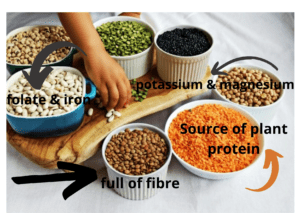
The first place belongs to one of the most powerful food groups on the planet – beans. They are low in fat and high in folate, potassium, iron, and magnesium. Legumes contain a health-promoting ingredient – fiber, which helps to reduce blood pressure and bad cholesterol level, as well as strengthen the function of the immune system. Beans are a great source of plant protein, and they are inexpensive, compared to meat, which has more fat and cholesterol.
Beans, chickpeas, soy, lentils, and other legumes are the cornerstones of most centenarian diets (centenarians-people who lived up to 100 years and more). They were hailed as a key dietary predictor of longevity in a study that found a daily dietary increase of just 20 grams (less than an ounce) of legumes lowers our risk of dying in any given year by 8%.
I love beans because of their versatility and rich nutrition profile. You can make soups, stews, and curries; add them to your favorite salad; or even make desserts out of them.
Try the following delicious recipes to incorporate more beans into your daily menu:
Lima Bean Soup with Brown Rice
Bean & Bell Pepper Wrap Recipe
Lentil Salad with Smoked Chicken
Black-eye Bean Salad for Easy Lunch
Classic Greek Boiled Beans Recipe – A Nutritious Mediterranean Dish
Protein-Packed Instant Pot Turkey Chili
2. Spinach, Kale & Other Leafy Greens
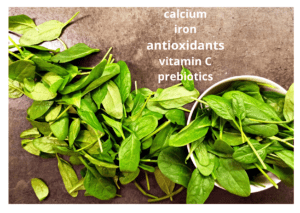
Green leafy vegetables, such as kale, collard greens, spinach, and Swiss chard,-are anti-inflammatory superstars.
Leafy greens are rich sources of antioxidants, which protect cells from degeneration and damage by oxidative stress. They also contain fiber, well known for its beneficial properties for our health.
Leafy greens contain iron, calcium, folate, potassium, magnesium, vitamin K, and vitamin C. Due to their low-calorie content, these green goodies help to maintain optimal body weight. As well as to reduce the risk of several chronic diseases (from type 2 diabetes to cardiovascular problems).
Leafy greens are packed full of vitamin A, an antioxidant that serves as a huge booster to the immune system and healthy cell growth (3). For example, just by consuming 67 g of kale, you cover the daily requirements for vitamin A and vitamin K, and ascorbic acid.
Green vegetables are also an excellent source of prebiotics, which are needed to nourish and multiply beneficial flora in the oral cavity.
Leafy greens are now available throughout the year, so diversifying the menu and improving your health with it is not difficult.
Discover NutriQuorum Recipes including this amazing superfood:
 Green Smoothie to Boost Your Energy
Green Smoothie to Boost Your Energy
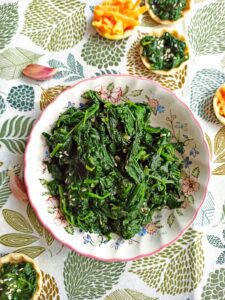 Garlicky Spinach with Sesame Oil
Garlicky Spinach with Sesame Oil
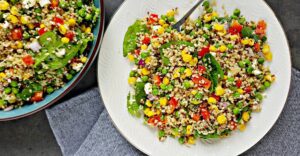
Quinoa Salad with Spinach & Feta Cheese

3. Sweet Potatoes

Sweet potatoes have a rich orange color and a pleasant taste. One medium-sized sweet potato is enough to fill the body with:
- 4 g of fiber;
- 3 g of protein;
- ascorbic acid;
- vitamin B6, manganese, and potassium.
The fiber in sweet potatoes is represented by lignin and cellulose. That coarse fiber stimulates the intestines, activates its motility, and provokes the act of defecation. One study examined the effect of sweet potatoes on the gastrointestinal tract of patients undergoing chemotherapy. It is known that such treatment very often causes the formation of constipation. After 4 days of regular consumption of sweet potatoes in the amount of 200 g, the gastrointestinal tract normalized in the participants, and the symptoms of constipation became less pronounced.
Sweet potatoes contain almost 11 times more vitamin A than the recommended amount. Scientists have found that vitamin A has anti-cancer properties.
Try this Sweet Potato Curry with Tofu, and you will fall in love with this orange super-food 😊
Read more about health benefits of sweet potatoes on my blog post Sweet Potato: A Health Revolution on Your Plate.
4. Pumpkin

Another orange “storehouse” of vitamins and minerals. Pumpkin is a rich source of antioxidants such as alpha and beta carotenes. These natural active substances only destroy free radical molecules without harming healthy cells in the body. Pumpkin contains a lot of beta-carotene. Our body has a unique ability – it converts beta-carotene into vitamin A.
Medical studies prove that vitamin A maintains, and strengthens the immune system, and helps fight bacterial and viral infections.
More than 10 studies have been conducted to elucidate the anti-cancer properties of alpha- and beta-carotene. All experiments have shown that eating pumpkins reduce the likelihood of stomach cancer. Carotenoids have shown antitumor activity against cancer of the pancreas, throat, and mammary glands. Several leading medical institutes continue to study the beneficial anti-cancer properties of pumpkin pulp in relation to other types of cancer.
You can add pumpkin to everything from soups to pasta.
I welcome you to try these NutriQuorum Recipes with Super Food Pumpkin:
Pumpkin Soup with a Secret Ingredient
Pasta Salad with Roasted Butternut Squash
Easy Pumpkin Stew with Kidney Beans
Rice with Roasted Pumpkin & Cottage Cheese
5. Walnuts
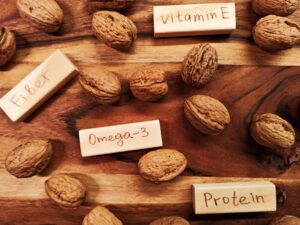
Good source of plant protein, as well as healthy unsaturated fats. Walnuts are loaded with folates, vitamin E, and alpha-linolenic acid (omega-3 fatty acids). Omega-3 has been linked with better heart health, due to its anti-inflammatory properties. People, who eat more than 3 servings of walnuts per week may cut their risk of dying from cancer in half.
Only 4-7 walnuts contain 2.5 grams of omega-3s, which is more than 2 times the minimum requirement for an adult.
Thanks to fatty acids and vitamin E, walnut is an excellent prevention of type 2 diabetes. The study involved 100 people with type 2 diabetes. The control group was given 1 tablespoon of cold-pressed walnut oil every day for 3 months (while continuing with regular diabetes medications and a balanced diet). As a result, it was possible to reduce fasting blood sugar levels by 8%, compared with the placebo group.
How to introduce this Superfood to your diet:
- replace meat in pasta dishes or salads;
- add nuts to your Quinoa Salads or Rice Salad
- nuts are great for snacking;
- goes well with oatmeal or porridge for breakfast;
- try our NutriQuorum Easy Granola Recipe;
- sprinkle some walnuts on Nutritious & Colorful Fruit Salad
Serving size: 2 Tbsp nut butter or 30 g nuts.
To sum up the given information
Let’s heed the advice of Michael Pollan: Eat food. Not too much. Mostly plants. That is the golden rule for me. I decided to have an 80/20 diet. 80% of my food is plant-based and the rest 20% is animal products. Understand, a piece of meat or cheese will not kill you. But for the sake (for the benefit) of your health, make these products a complement to your main meals, consisting of plant foods, such as beans, legumes, vegetables, etc. Why? The answer is very simple. Only plants contain fiber, don’t contain bad cholesterol, and are full of nutrients such as antioxidants.
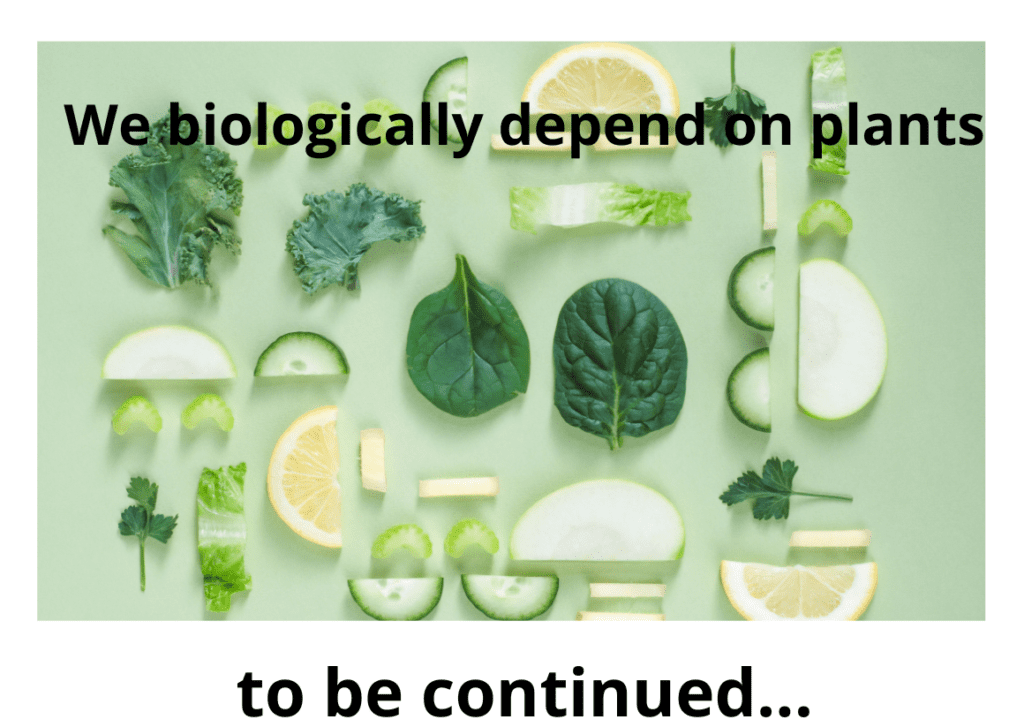
REFERENCES:
- “How not to die” Michael Greger.
- “In defense of food an eater manifesto”, Michael Pollan.
- National Library of Medicine and National Center for Biotechnology Information (please, check the links in the text above).





